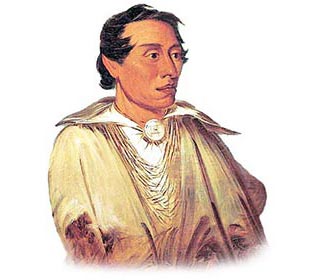|
|
The name of the Native Indian in the picture of the Kickapoo Prophet Indian is Kee-αn-ne-kuk, Foremost Man, Chief of the Tribe, 1830, Kickapoo tribe. The picture of him raises different points of interest which increase knowledge and understanding of Native Indian tribes:
The title we have given the picture reflects the name of the tribe, for ease of identification. Description of the Picture The present chief of this tribe usually called the Prophet, is a very shrewd and talented man. When he sat for his portrait, he took his attitude as seen in the picture, which was that of prayer. And I soon learned that he was a very devoted Christian. It was told to me in the tribe by the Traders (though I am afraid to vouch for the whole truth of it), that while a Methodist preacher was soliciting him for permission to preach in his village, the Prophet refused him the privilege, but secretly took him aside and supported him until he learned from him his creed, and his system of teaching it to others; when he discharged him, and commenced preaching amongst his people himself; pretending to have had an interview with some inspired personage; ingeniously resolving, that if there was any honour or influence to be gained by the promulgation of it, he might as well have it as another person; and with this view he commenced preaching and instituted a prayer, which he ingeniously carved on a maple stick of an inch and a half in breadth, in characters somewhat resembling Chinese letters. These sticks, with the prayers on them, he has introduced into every family of the tribe, and into the hands of every individual; and as he has necessarily the manufacturing of them all, he sells them at his own price; and has thus added lucre to fame, and in two essential and effective ways, augmented his influence in his tribe. The Manners, Customs and Conditions of the North American Indians (1832 - 1839) |
| Next Native Indian Picture |
| Pictures of Native Americans Gallery |
| Native Indian Tribes Index |
|
First Published2016-04-19 | ||
Updated 2018-01-01 | Publisher Siteseen Limited | |
|
